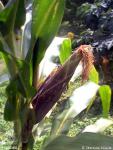1 WENIGER B, ROUZIER M, 1986 Enquête TRAMIL. Service Oecuménique d'Entraide SOE, Port au Prince, Haïti.
2 GERMOSEN-ROBINEAU L, GERONIMO M, AMPARO C, 1984 Encuesta TRAMIL. enda-caribe, Santo Domingo, Rep. Dominicana.
3 FLATH RA, FORREY RR, JOHN JO, CHAN BG, 1978 Volatile components of corn silk (Zea mays): possible Heliothis zea (boddie) attractants. J Agric Food Chem 26:1290-1293.
4 GUELDNER RC, SNOOK ME, WIDSTROM NW, WISEMAN BR, 1992 tlc screen for maysin, chlorogenic acid, and other possible resistance factors to the fall armyworm and the corn earworm in zea mays. J Agric Food Chem 40(7):1211-1213.
5 STYLKEES ED, CESKA O, 1975 Genetic control of 3-hydroxy- and 3-deoxy-flavonoids in Zea mays. Phytochemistry 14:413-415.
6 ELLIGER CA, RABIN LB, 1981 Separation of plant polyphenolics by chromatography on a boronate resin. J Chromatogr 216:261-268.
7 ELLIGER CA, CHAN BG, WAISS AC, LUNDIN JR RE, HADDON WF, 1980 C-glycosylflavones from Zea mays that inhibit insect development. Phytochemistry 19:293-297.
8 DOMINGUEZ XA, BUTRUILLE D, ALVAREZ E, 1976 Note on a chemical study of cabello de elote. Rev Latinoamer Quim 7:93.
9 BALANSARD J, 1951 A study of the hepato-renal diuretics. xxxv. the presence of glycolic acid in various drugs used as diuretics. Med Trop (Marseille) 11:638-639.
10 BUTTERY RG, LING LC, CHAN BG, 1978 Volatiles of kernels and husks: Possible corn ear worm attractants. J Agric Food Chem 26:866-869.
11 BUTTERY RG, LING LC, 1984 Corn leaf volatiles: Identification using tenax trapping for possible insect attractants. J Agric Food Chem 32(5):1104-1106.
12 TAKAGI S, 1985 Determination of green leaf carotenoids by hplc. Agr Biol Chem 49(4):1211-1213.
13 NEURATH GB, DUNGER M, PEIN FG, AMBROSIUS D, SCHREIBER O, 1977 Primary and secondary amines in the human environment. Food Cosmet Toxicol 15(4):275-282.
14 HOFMAN J, HOFMANOVA O, 1969 1,4-benzoxazine derivatives in plants. Sephadex fractionation and identification of a new glucoside. Eur J Biochem 8(1):109-112.
15 SAKATA K, YAMAMOTO H, TANAKA H, SHINOZUKA M, 1982 Studies of components of raw corn (zea mays l.) and corn silage. 7. Components of the nonvolatile acidic fraction of raw corn and the volatile phenolic fraction of corn silage. Nippon Nogei Kagaku Kaishi 56:451-453.
16 UNSELD E, KRISHNA DR, FISCHER C, KLOTZ UL, 1989 Detection of desmethyldiazepam and diazepam in brain of different species and plants. Biochem Pharmacol 38(15):2473-2478 (1989)
17 CHITWOOD DJ, HUTZELL PA, LUSBY WR, 1985 Sterol composition of the corn cyst nematode, Heterodera zeae, and corn roots. J Nematol 17(1):64-68.
18 FELDMAN LJ, ARROYAVE NJ, SUN PS, 1985 Abscisic acid, xanthoxin and violaxanthin in the caps of gravistimulated maize roots. Planta 166(4):483-489.
19 BUTTERY RG, LING LC, 1985 Volatile components of corn roots: Possible insect attractants. J Agric Food Chem 33(4):772-774.
20 DUKE JA, ATCHLEY AA, 1986 Handbook of proximate analysis tables of higher plants. Boca Raton, USA: CRC Press. p172.
21CACERES A, MENENDEZ H, MENDEZ E, COHOBON E, SAMAYAO BE, JAUREGUI E, PERALTA E, CARRILLO G, 1995 Antigonorrhoeal activity of plants used in Guatemala for the treatment of sexually transmitted diseases. J Ethnopharmacol 48(2):85-88.
22 CACERES A, GIRON LM, MARTINEZ AM, 1987 Diuretic activity of plants used for the treatment of urinary ailments in Guatemala. J Ethnopharmacol 19(3):233-245.
23 GRASES F, MARCH JG, RAMIS M, COSTA-BAUZÁ A, 1993 The influence of Zea mays on urinary risk factors for kidney stones in rats. Phytother Res 7(2):146-149.
24 DE A RIBEIRO R, FIUZA DE MELO MMR, DE BARROS F, GOMES C, TROLIN G, 1986 Acute antihypertensive effect in conscious rat produced by some medicinal plants used in the state of Sao Paulo. J Etnopharmacol 15(3):261-270.
25DE A RIBEIRO R, BARROS F, MARGARIDA M, MELO RF, MUNIZ C, CHIEIA S, WANDERLEY MG, GOMES C, TROLIN G, 1988 Acute diuretic effects in conscious rat produced by some medicinal plants used in the state of Sao Paulo, Brasil. J Etnopharmacol 24(1):19-29.
26DOAN DD, NGUYEN NH, DOAN HK, NGUYEN TL, PHAN TS, VAN DAU N, GRABE M, JOHANSSON R, LINDGREN G, STJERNSTROM NE, 1992 Studies on the individual and combined diuretic effects of four Vietnamese traditional herbal remedies (Zea mays, Imperata cylindrica, Plantago major and Orthosiphon stamineus). J Ethnopharmacol 36(3):225-231.
27 ARTECHE A (Ed.), 1998 Zea mays, Fitoterapia, Vademecum de Prescripción, Base de Datos FITOS para Windows v1.0, Editorial Masson SA, Madrid, España.
28 WICHTL M, ANTON R, 1999 Plantes thérapeutiques. Paris, France: TEC & DOC. p334.
29 LOPEZ M, MARTINEZ MJ, MOREJON Z, BOUCOURT E, FUENTES V, MORON F, 2005 Irritabilidad dérmica primaria de semilla fresca machacada de Zea mays L. Informe TRAMIL. Laboratorio Central de Farmacología, Facultad de Medicina “Dr. Salvador Allende”, Cerro, C. Habana, Cuba.






